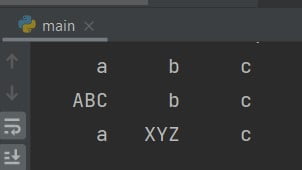Use format to print table aligns in Python. Using the .format approach, you could use padding to align all of your strings.
You can also use tabulate module for it.
Python print table align example
Simple example code text formatting rows in Python.
table_data = [
['a', 'b', 'c'],
['ABC', 'b', 'c'],
['a', 'XYZ', 'c']
]
for row in table_data:
print("{: >5} {: >5} {: >5}".format(*row))
Output:

Another example
header = ['X Coordinate', 'Y Coordinate', 'Result']
row = ['100', '200', '300']
rows = [header, row, row, row]
print('\n'.join([''.join(['{:16}'.format(x) for x in r]) for r in rows]))
Output:
X Coordinate Y Coordinate Result
100 200 300
100 200 300
100 200 300 Or, using f-strings:
print('\n'.join([''.join([f'{x:16}' for x in r]) for r in rows]))Tabulate
One possible solution is to rely on some package that has been designed for this purpose, like tabulate: Read more about it!
from tabulate import tabulate
print(tabulate([[0, 1, 2], [3, 4, 5], [6, 7, 0]],
headers=['X', 'Y', 'Z'],
tablefmt='orgtbl'))
Output:
| X | Y | Z |
|-----+-----+-----|
| 0 | 1 | 2 |
| 3 | 4 | 5 |
| 6 | 7 | 0 |IF… you do not like the dashes, you can use this instead:
print(tabulate(table, tablefmt="plain"))How to Print “Pretty” String Output in Python?
Standard Python string formatting may suffice.
template = "{0:8}|{1:10}|{2:15}|{3:7}|{4:10}" # column widths: 8, 10, 15, 7, 10
print(template.format("CLASSID", "DEPT", "COURSE NUMBER", "AREA", "TITLE")) # header
for rec in your_data_source:
print
template.format(*rec)
Do comment if you have any doubts or suggestions on this Python table topic.
Note: IDE: PyCharm 2021.3.3 (Community Edition)
Windows 10
Python 3.10.1
All Python Examples are in Python 3, so Maybe its different from python 2 or upgraded versions.